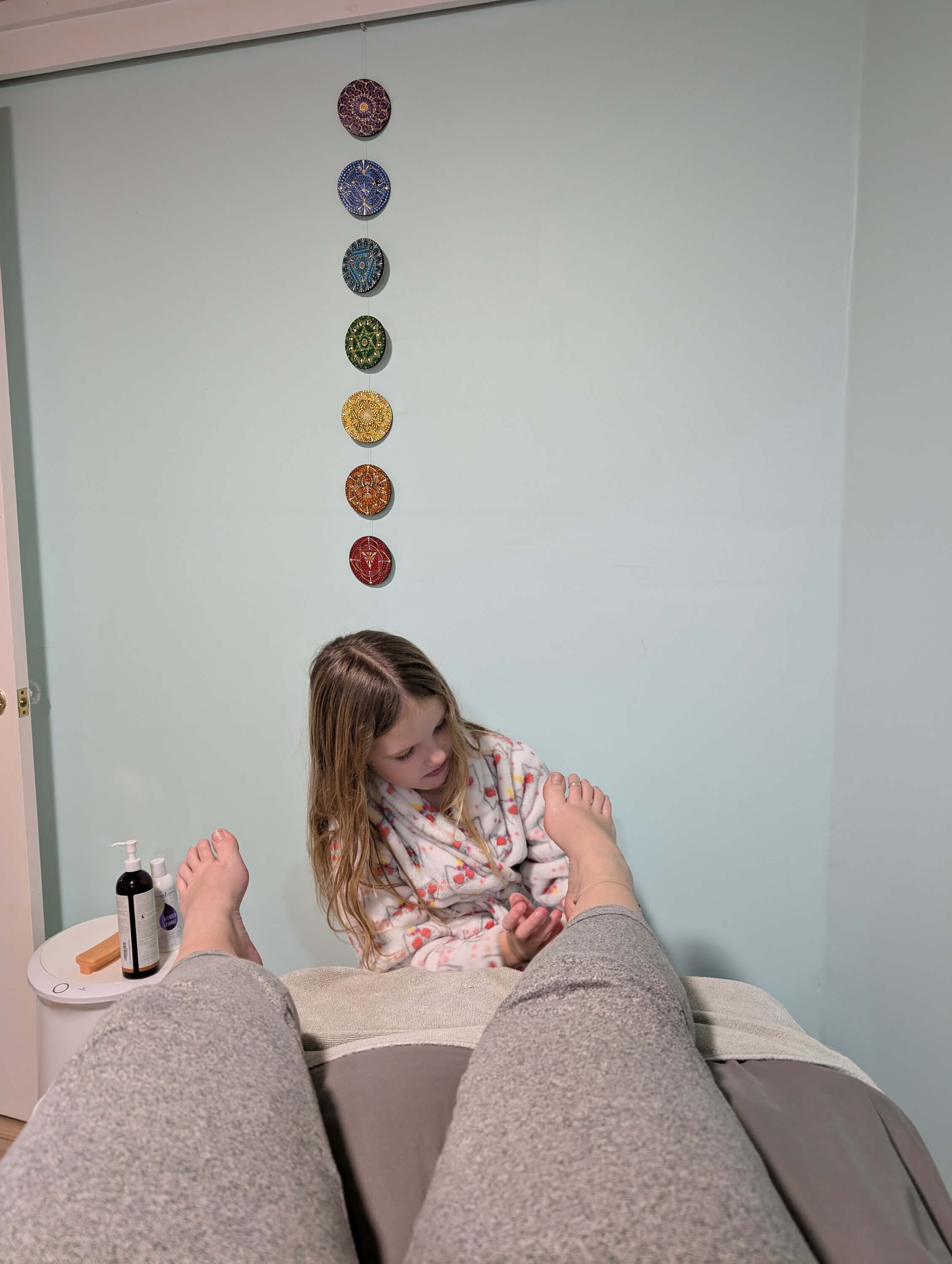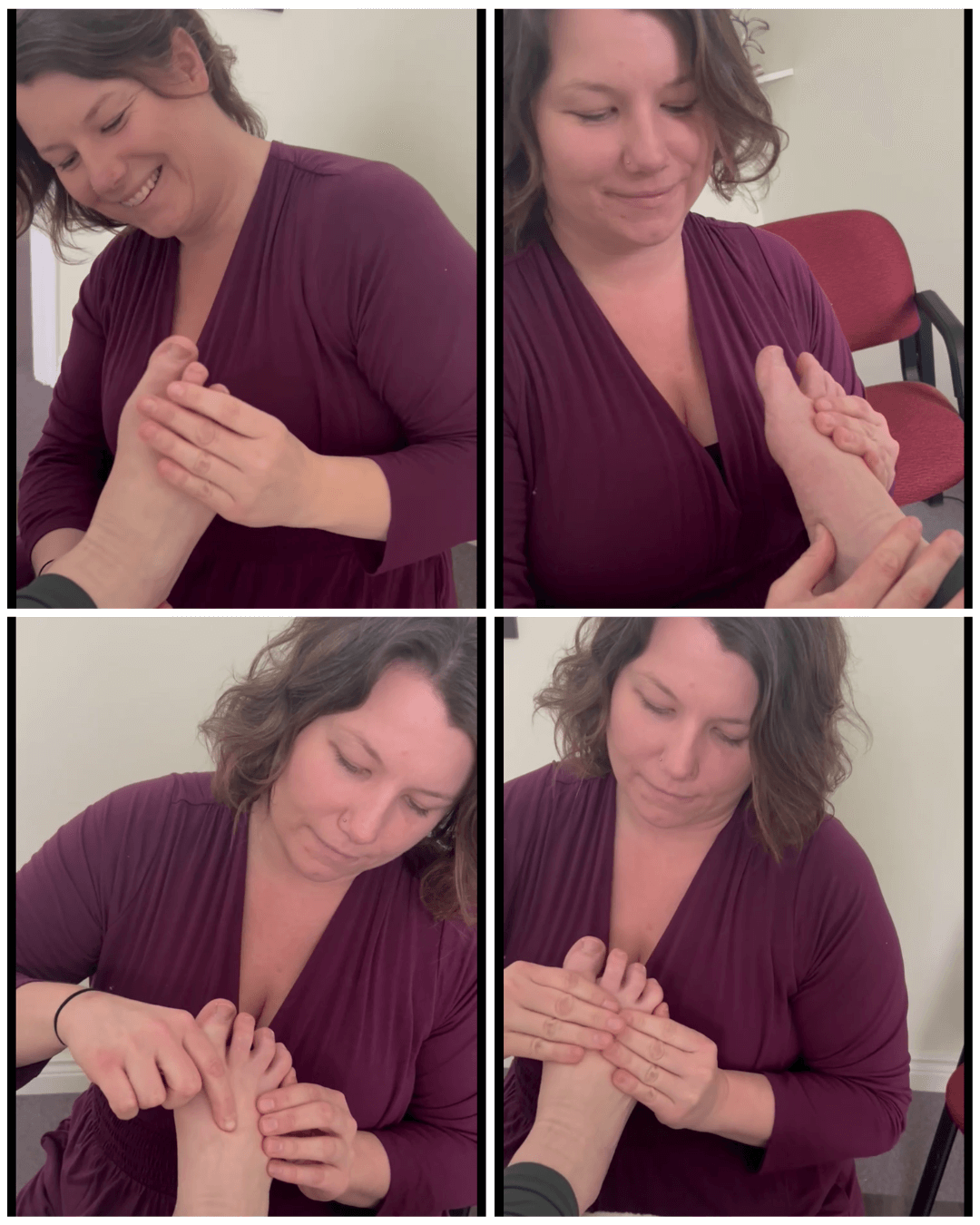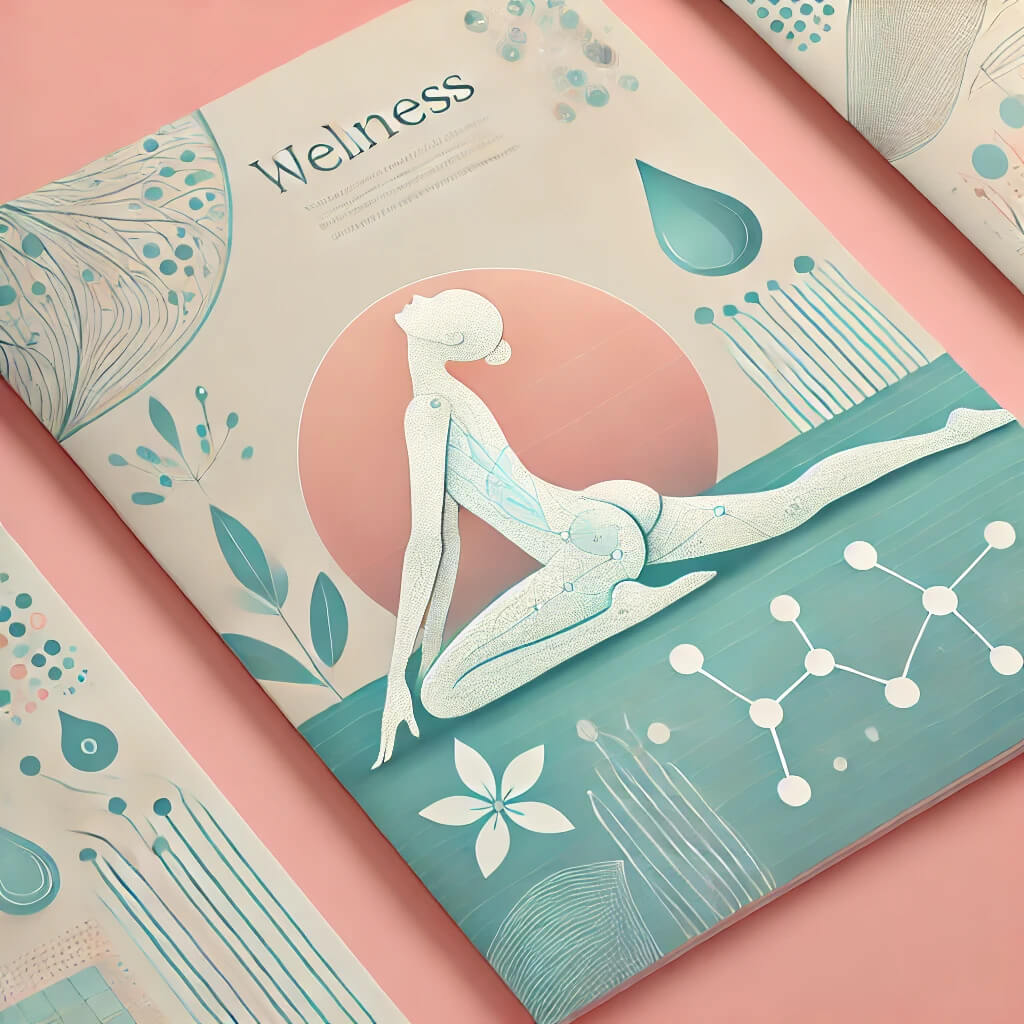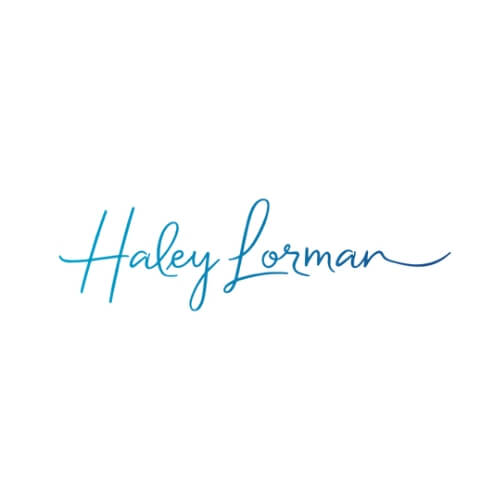The Secret to Self-Care When You Have No Time
As a busy mom, you've probably heard it a hundred times: "You can't pour from an empty cup." But between work, family, and the never-ending to-do list, self-care often feels like an impossible luxury. Who has time for long bubble baths or spa days when you're just trying to keep up with life?
Here's the truth: Self-care doesn't have to be time-consuming. In fact, some of the most powerful self-care practices take just seconds—and they can make a world of difference in how you feel.
Why Quick Self-Care Works
Your nervous system doesn't need an entire afternoon off to reset. Small, intentional moments of care—like deep breathing, reflexology, or sound healing—can bring you back to balance in just minutes. The key is knowing what to do and when to do it.
Most of us operate in "fight or flight" mode throughout the day, with stress hormones constantly flooding our systems. Quick self-care practices interrupt this cycle, giving your body permission to activate the parasympathetic nervous system—your body's natural relaxation response. Even 30 seconds of intentional care can shift your entire mental state and energy level.
A Simple Self-Care Hack You Can Try Right Now
Take a deep breath in through your nose for four seconds. Hold for four seconds. Then exhale slowly for six seconds. Repeat three times.
Feel the shift? That's your body moving from stress mode to calm mode in under a minute. This is just one of many simple but effective techniques that can fit into your daily routine, no matter how packed it is.
When to Use Quick Self-Care
The beauty of these micro-moments is that you can use them anywhere:
- While waiting in the school pickup line
- Between Zoom meetings
- During your morning coffee ritual
- When you feel overwhelmed by your to-do list
- Right before bed to help you fall asleep faster
The key is consistency. Rather than saving self-care for "someday" when you magically have more time, these quick practices can become natural parts of your everyday life—no extra time required.
Get Your Free Self-Care Cheat Sheet
If you're ready to make self-care effortless, I've put together Self-Care in Seconds: The Ultimate Cheat Sheet for Busy Moms. It's a beautifully designed one-page guide filled with quick, powerful self-care techniques that you can use anytime, anywhere.
✔️ No extra time required ✔️ Simple, proven techniques ✔️ A small shift that makes a BIG impact
Because you deserve self-care that actually fits into your life—and your schedule.

Real Talk: The Natural Tools Every Parent Should Have in Their Wellness Toolbox
Can we talk about something that's been on my heart lately?
You know those moments when your kiddo isn't feeling great, and you just wish you had more tools to help them feel better? I've been there. And as both a mom and a reflexologist, I've discovered some pretty amazing natural solutions that I'm literally using with my girls all the time.
Here's the Thing About Natural Wellness...
It's not luck when your kids bounce back quickly from being under the weather - it's having the right tools and knowing how to use them!
Just yesterday, someone said to me "lucky you" when I mentioned my girls typically only feel off for 12-48 hours. But here's the truth: it's not luck at all. It's about having a toolbox of natural solutions ready to go and knowing exactly when to pull them out.
And you know what? One of my absolute favorite tools is reflexology. I know, it might sound fancy, but stay with me here!
What's This Reflexology Thing All About?
Think of it like having a magic map on your feet and hands that connects to every part of your body. Cool, right? By applying gentle pressure to specific points, you can help:
- Calm those bedtime jitters
- Ease tummy troubles
- Support their immune system
- Help them feel more balanced when emotions are running high
And the best part? You can do it anywhere, anytime. No special equipment needed - just your loving hands! You can even teach them to do it on themselves!
Real Mom Life Example
Let me share something that happened just last week. My youngest was feeling a bit off at bedtime - you know that mom instinct when you can just tell something's brewing? Instead of worrying all night, I pulled out my reflexology tools. A little foot work, some gentle pressure points, and she drifted off to sleep way more peacefully than she would have otherwise.
This is the kind of stuff I use ALL THE TIME with my girls. And honestly? It's created such a beautiful bonding experience between us. They actually ask for their "special foot time" (sometimes every hour of the day)
Why I Created This Workshop
Here's the deal - I've been sitting on these tools for a couple of years, using them with my own family, and recently had this total lightbulb moment (literally at 1 AM - when all good ideas seem to happen, right?). Why am I not sharing these techniques with other parents?
Because let's be real - every parent deserves to have these tools in their back pocket. And I promise, it's way simpler than you might think!
What You'll Actually Learn
In this super practical, no-fluff workshop, I'm sharing:
- Quick techniques you can use right away
- Methods that work anywhere (perfect for those middle-of-the-night moments)
- Skills that actually work and that you'll use for years to come
- Ways to create even deeper bonds with your kiddos through healing touch
The best part? You don't need any special background or fancy equipment. Just your hands and a willingness to learn!
Let's Make This Happen!
I'm keeping this workshop super accessible because I really believe every parent should have these tools:
- Regular investment: $29
- Early Bird Special until February 28th: $19 (use code "EarlyBird" at checkout)
- Date: March 31st at 6 PM EST
- Where: Right on Zoom (so you can learn from your cozy spot at home!)
One Last Thing...
You know that feeling when you wish you could do more to help your little ones feel better? That's exactly why I created this workshop. Because having these tools has been such a game-changer for my family, and I know it can be for yours too.
Ready to add some powerful natural tools to your parenting toolbox? Grab your spot now - I'm keeping the group small so everyone gets plenty of attention and can ask all their questions!
P.S. The Early Bird price is only available until the end of February! Don't wait to grab your spot at this special rate!

Let's Talk About The Magic Of Reflexology: Your Path To Stress Relief
Picture this: You're curled up on your couch after a long day, feeling like your shoulders are carrying the weight of the world. Your mind is racing like a hamster on a wheel, and your body feels as tight as a rubber band ready to snap.
We've all been there, haven't we? Our bodies and minds are crying out for relief.
This is where the gentle art of reflexology comes in.
Understanding How Stress Impacts Our Body
Before we dive into the powers of reflexology, let's understand what stress actually does to us. You might be surprised to learn that stress affects nearly every system in your body:
Your nervous system gets stuck in "fight or flight" mode, making you feel anxious and alert when you should be relaxing. Your endocrine system releases stress hormones like cortisol, which can lead to weight changes and tiredness. Your heart works harder, your immune system gets weaker, and your digestion might act up (hello, stress eating and tummy troubles!).
Stress can also cause your muscles to tense up, leading to those familiar headaches and back pain. It might make your breathing shallow, affect your reproductive health, and even show up on your skin or in your hair. That's a lot for our bodies to handle, isn't it?
What Makes Reflexology So Special?
Think of your feet and hands as maps of your body - each part connects to these different systems we talked about. When a trained reflexologist works with these points, it's like sending a calming message throughout your entire body, helping each system find its natural balance again.
How Your Body Benefits During a reflexology session, something beautiful happens:
- Your nervous system shifts from stress mode to rest mode
- Your circulation improves, bringing fresh energy everywhere it's needed
- Those stress hormones start to calm down
- Tense muscles begin to relax
- Your body's natural healing abilities get a gentle boost
- Many people find their sleep improves and their mood lifts
Your First Experience
Walking into your first reflexology session is like opening a new chapter in your wellness story. The treatment room welcomes you like a warm embrace. Your reflexologist will use gentle pressure on specific points of your feet, hands, body or face. Many people find themselves drifting into a deeply relaxed state - it's like giving your body permission to finally let go of all that tension.
Simple Ways to Start at Home While seeing a trained reflexologist gives you the complete experience, you can bring some reflexology into your daily life:
- Take a few minutes before bed to massage your feet with loving attention
- Enjoy a warm foot soak with Epsom salts
- Practice slow, deep breathing while giving attention to your feet or hands
A Gift of Healing
Remember, caring for yourself isn't selfish - it's necessary, especially when stress affects so many parts of our wellbeing. Reflexology offers a natural, nurturing way to help your body remember its own healing wisdom. Whether you're dealing with daily stress or looking to support your overall health, reflexology can be a wonderful addition to your self-care routine.
If you feel drawn to try reflexology, I encourage you to reach out to a certified practitioner. Your body has an amazing ability to heal and find balance - sometimes it just needs a little loving support to remember how.
Take gentle care of yourself. Your body works so hard for you every day - it deserves this gift of healing and relaxation.
Remember, every journey begins with a single step - perhaps yours could start with caring for those precious feet that carry you through each day.
Ready to Experience the Magic of Reflexology?
Your body is always speaking to you—it's time to listen and give it the care it deserves. If stress has been weighing you down, reflexology can be the gentle, healing touch your body craves.
Book a session with a certified reflexologist today and discover the relief and relaxation waiting for you.
Not ready for a session yet? Try a simple foot massage tonight and feel the difference.
Your journey to balance, relaxation, and healing starts with one small step—let it be one of self-care.
Reach out today and begin your path to stress relief!
 The Silent Symptoms of Mom Burnout (That You Might Be Ignoring
The Silent Symptoms of Mom Burnout (That You Might Be IgnoringWe all know what burnout looks like in the movies: a dramatic breakdown, tears over spilled coffee, or a suddenly empty wine bottle. But in real mom life? Burnout often whispers before it screams, showing up in subtle ways we might brush off as "just part of being a mom."
Let's talk about those silent symptoms – the ones you might be dismissing right now with a shrug and another sip of coffee.
1. Brain Fog & Forgetfulness
You know that moment when you walk into a room and completely forget why? Or when you have to read the same paragraph three times? It's not just "mom brain." When burnout creeps in, your cognitive function takes a hit. Your brain is actually protecting itself by making it harder to process new information when you're overwhelmed.
**What it might look like:**
- Forgetting appointments you just made
- Struggling to follow simple recipes you've made countless times
- Reading the same email multiple times without absorbing it
- Losing your train of thought mid-sentence
2. Emotional Numbness
Remember when you used to get excited about weekend plans or your favorite TV show? If those things now feel more like items on a to-do list, you might be experiencing emotional exhaustion. This numbness isn't depression (though they can coexist) – it's your emotional fuse burning out after running too hot for too long.
**Real talk moments:**
- Feeling like you're watching your life through a window
- Not getting joy from activities you used to love
- Going through the motions of family time without feeling present
- Finding it hard to celebrate others' good news
3. Increased Irritability
If you've found yourself snapping at the smallest things – your kid's humming, your partner's breathing, the way someone loaded the dishwasher – you're not turning into a monster. Your nervous system is overwhelmed, making every little irritation feel like the last straw.
**Signs to watch for:**
- Zero tolerance for normal kid noise
- Getting disproportionately angry about minor inconveniences
- Feeling instantly annoyed when someone asks for help
- Having a shorter fuse than usual with your partner
4. Body Aches & Tension
Your body keeps score of stress long before your mind admits it. Those mysterious aches and pains? They're your body's way of waving a red flag.
**Physical signs to notice:**
- Tension headaches that come out of nowhere
- Shoulders that feel like they're touching your ears
- Jaw pain from unconscious clenching
- Lower back pain that doesn't have a clear cause
5. Loss of Motivation
Remember when you used to have big plans and exciting goals? Burnout can make even getting dressed feel like climbing a mountain. This isn't laziness – it's your body's way of forcing you to slow down when you've been pushing too hard for too long.
**How it shows up:**
- Procrastinating on basic tasks you usually handle easily
- Feeling overwhelmed by simple decisions
- Losing interest in hobbies or personal goals
- Struggling to start anything new
6. Sleep Issues
The cruel irony of burnout is that when you most need rest, it becomes hardest to get it. Either you can't fall asleep because your mind won't quiet down, or you sleep for hours but wake up feeling like you haven't rested at all.
**Warning signs:**
- Lying awake worrying about tomorrow's to-do list
- Waking up multiple times during the night
- Feeling exhausted even after a full night's sleep
- Wanting to nap but feeling too wired to actually sleep
7. Reliance on Quick Fixes
When your energy tank is running on empty, it's natural to reach for whatever will keep you going. But if you find yourself needing more and more just to function, it might be time to look at what's driving that need.
**Red flags:**
- Needing coffee to speak to anyone in the morning
- Craving sugar or carbs for quick energy boosts
- Using wine to "wind down" most nights
- Depending on energy drinks to get through afternoon slumps
Real Stories of Recovery
Sometimes the best way to understand burnout recovery is through the eyes of those who've been there. Here are some stories from our community:
A Family's Journey to Wellness
"My experience with reflexology has been transformative – not just for me, but for my whole family. When I first started, I wasn't even sure what reflexology was, but I took a chance on a pay-by-donation session. Now, both my son and my mom are regular clients too!
What struck me most was how comprehensive the care is. It's not just about the physical touch – it's about understanding what's happening in your body and why. The calm, educational approach helped me connect the dots between my symptoms and their causes. Having someone explain things in a soothing, knowledgeable way made all the difference in my healing journey."
- Mom and Regular Client
A Senior's Perspective on Prevention
For those wondering if burnout care is a long-term investment, listen to this clients experience:
"As a senior, I've learned that prevention is key. My monthly reflexology sessions have become an essential part of my wellness routine. Beyond just relaxation, I've noticed improvements in:
- Stress management
- Anxiety reduction
- Better emotional regulation
- Increased energy levels
- Enhanced sleep quality
- Stronger immune system
What keeps me coming back isn't just the hour of pampering (though that's lovely!) – it's the lasting sense of wellbeing I carry with me long after each session."
The Ripple Effect of Self-Care
One of the most beautiful things about addressing burnout is how it positively impacts those around you. When you're less stressed, better rested, and more emotionally balanced, everyone around you benefits. It's like they say on airplanes – secure your own oxygen mask first.
"Haley, you are phenomenal at this work. Your attention to detail and genuine care make each session not just a treatment, but a transformative experience."
Finding Long-Term Relief
This clients story shows how regular sessions can become part of a sustainable self-care routine:
"I keep coming back because the sessions help me in so many ways – from improved flexibility to deep relaxation and relief from aches and pains. The facial reflexology sessions have been a particular discovery for me. Each visit is an opportunity to de-stress and truly treat myself.
What makes these sessions special is the calm, peaceful environment. You leave feeling renewed, and that feeling keeps you coming back. It's become my go-to solution when life gets overwhelming."
Beyond Traditional Reflexology
Many people don't realize that reflexology extends beyond foot work. My comprehensive approach includes:
Facial Reflexology Benefits:
- Deep relaxation
- Tension release in facial muscles
- Natural face lifting effects
- Headache relief
- Sinus pressure reduction
- Enhanced sleep quality
Body Reflexology:
- Improved flexibility
- Overall body tension release
- Better circulation
- Enhanced energy flow
- Deep relaxation
- Stress reduction
The beauty of these treatments is their cumulative effect. While each session provides immediate relief, regular visits help maintain:
- Sustained flexibility
- Ongoing stress management
- Consistent pain relief
- Overall wellness maintenance
What Now?
If you're nodding along to these symptoms, first know this: You're not failing. You're human. Burnout happens when we've been strong for too long, not when we're weak.
The first step isn't a complete life overhaul (because who has time for that?). Instead, start with:
1. **Acknowledgment**: Simply recognizing these symptoms as burnout rather than personal failure is powerful
2. **Micro-Breaks**: Find tiny pockets of rest in your day (even 2 minutes counts)
3. **Body Check-Ins**: Set phone reminders to notice where you're holding tension
4. **Support**: Share this article with other moms – sometimes just knowing we're not alone helps
5. **Professional Help**: Consider working with someone who can help release stored tension and stress
Remember: Taking care of yourself isn't selfish – it's necessary maintenance for the most important job in the world.
Ready to start addressing these symptoms? Book a session with me to begin releasing stored tension and create a sustainable self-care plan that actually fits your life.
This post was written by Haley, a certified reflexologist and mom of three who specializes in helping busy moms move from burnout to balance.

How Understanding Fascia Can Transform Your Well-being: A Mom's Guide to Better Movement and Energy
As moms, we carry the weight of the world—both physically and emotionally. This constant juggling act leads to stress, tension, and physical discomfort. But there's a hidden system in your body that could hold the key to greater balance, relief, and well-being: fascia.
Understanding Fascia: The Body's Hidden Network
Fascia is a thin, fibrous tissue that wraps around every muscle, organ, and bone in your body, creating a comprehensive connection network. Think of it as an intricate web that helps your body move as one unified system.
For busy moms, this interconnected system significantly impacts daily life. When self-care takes a back seat, fascia can become:
- Stiff and restrictive, causing neck and lower back pain
- Compromised from poor posture while carrying children
- Tense from prolonged desk work
- Restricted from emotional and physical stress
How Healthy Fascia Benefits Mothers
Physical Relief
Healthy fascia helps release tension in common problem areas like the neck, shoulders, and back. Simple techniques like gentle stretching or foot rolling can create profound relief.
Enhanced Energy Levels
When fascia functions optimally, it allows for free, efficient movement. This translates to better energy levels and reduced physical fatigue during daily activities.
Emotional Balance
The fascial system connects deeply with your nervous system. Working with fascia can help:
- Reduce stress levels
- Improve sleep quality
- Enhance overall mood
- Create better body awareness
Practical Fascia Care for Busy Moms
1. **Movement Integration**
- Set hourly reminders for quick stretches
- Take movement breaks between tasks
- Incorporate gentle yoga or walking
2. **Hydration Habits**
- Start each day with water
- Keep a water bottle nearby
- Monitor daily intake
3. **Self-Care Techniques**
- Use foam rollers for tension release
- Practice foot reflexology
- Implement gentle self-massage
The Reflexology Connection
Reflexology offers powerful support for fascial health by:
- Releasing tension patterns
- Creating flexibility in restricted areas
- Promoting systemic balance
- Providing crucial relaxation time
Your 10-Minute Daily Fascia Care Routine
1. Morning hydration (1 minute)
2. Full-body stretches (3 minutes)
3. Foot reflexology (3 minutes)
4. Midday movement break (2 minutes)
5. Evening tension release (1 minute)
Grab the practical, easy-to-follow daily routine I've called "The Mom Minute Method: Sneaky Stretches' for Busy Days"
Understanding and caring for your fascia can transform how you feel in your body. By incorporating these simple techniques into your daily routine, you can experience:
- Reduced physical tension
- Improved energy levels
- Better emotional balance
- Enhanced overall well-being
Remember, when you prioritize your fascial health, you're investing in your ability to show up as your best self—for your family and yourself.
Want to learn more about fascia care and motherhood? Book a session with a certified reflexologist today.


